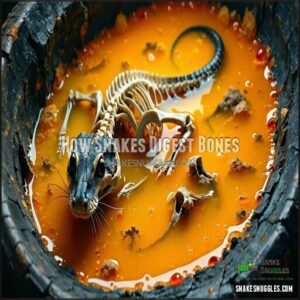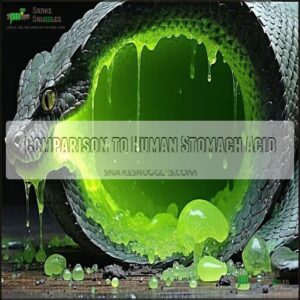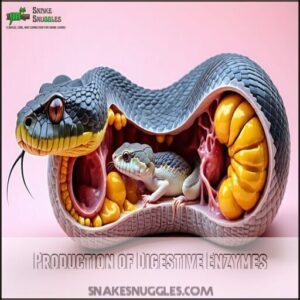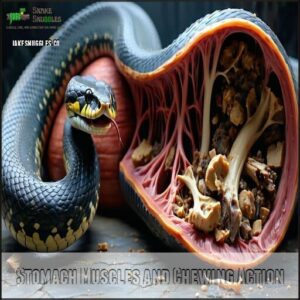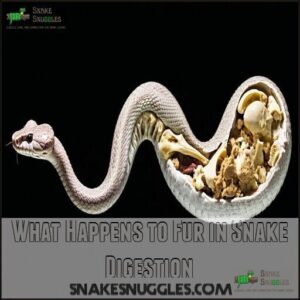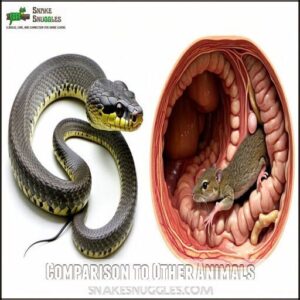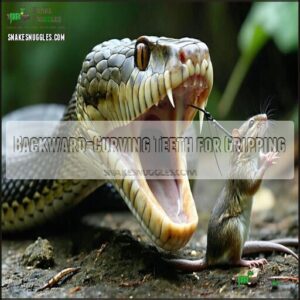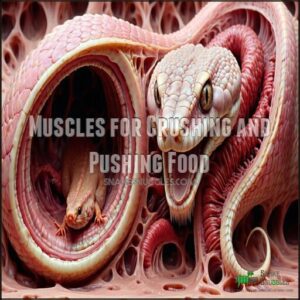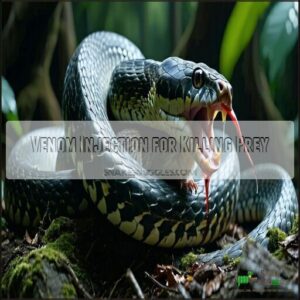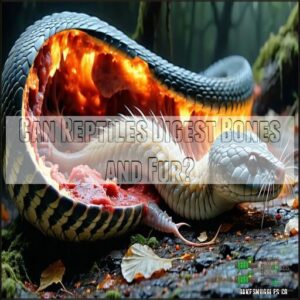This site is supported by our readers. We may earn a commission, at no cost to you, if you purchase through links.
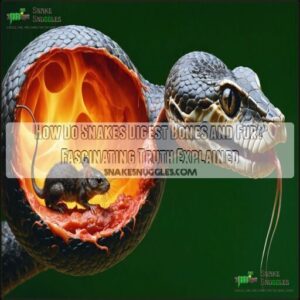
Their stomach acid is incredibly strong, much stronger than yours, and it breaks down bones over several days, allowing snakes to absorb nutrients like calcium.
Fur, on the other hand, is made of keratin, which even a snake’s powerful stomach can’t digest. Instead, the indigestible fur gets packed into a neat little ball and regurgitated, almost like a cat’s hairball.
Snakes’ muscular stomachs and specialized enzymes handle whole prey efficiently, making them masters of digestion. Ever wonder how their stomachs stay so tough despite all that work? There might be more to discover.
Table Of Contents
- Key Takeaways
- How Snakes Digest Bones
- Power of Snake Stomach Acid
- What Happens to Fur in Snake Digestion
- Comparison to Other Animals
- How Snakes Eat Whole Animals
- Can Reptiles Digest Bones and Fur?
- Frequently Asked Questions (FAQs)
- How do snakes digest hair?
- How do snakes break bones?
- How do snakes digest feathers?
- How does a snake digest animals?
- How do snakes digest animals whole?
- How do reptiles digest bones?
- Do snakes bones break?
- What happens to the bones of an animal a snake eats?
- Do snakes regurgitate hair?
- How do snakes eat whole animals?
- Conclusion
Key Takeaways
- Snakes digest bones with extremely strong stomach acid (pH as low as 1.5) and specialized enzymes, extracting essential nutrients like calcium.
- They can’t digest fur because it’s made of keratin, so they regurgitate it as compacted furballs after breaking down the edible parts.
- Flexible jaws and powerful stomach muscles let snakes swallow large prey whole and efficiently process it over days.
- Venomous snakes start digestion with their venom, which breaks down tissue even before swallowing, speeding up the overall process.
How Snakes Digest Bones
Snakes break down bones using their incredibly strong stomach acid, which can reach a pH as low as 1.5.
This acid, combined with specialized enzymes, completely dissolves the minerals and proteins in bones over several days.
Snakes’ Strong Stomach Acid and Digestive Enzymes
A snake’s stomach is like nature’s ultimate clean-up crew, breaking down even the toughest materials.
The snake’s stomach dissolves the indissoluble, turning bones and tissue into life-sustaining fuel with unmatched digestive power.
With incredibly strong stomach acid and specialized enzymes, snakes efficiently digest bones, extracting essential nutrients with precision. Stomach acid, with a pH as low as 1.5, works like a powerful chemical solvent, dissolving calcium compounds in the bones. Enzymes target essential proteins like collagen, further assisting the breakdown of bone structure.
Here’s how their digestion system excels in recycling prey:
- Acid Strength: Hydrochloric acid dissolves minerals and calcium-rich materials.
- Enzyme Types: Proteins and connective tissues are dismantled by proteases and collagen-digesting enzymes.
- Digestion Efficiency: Continuous secretion guarantees bones are reduced entirely, absorbing maximum nutrients.
This system keeps metabolic costs low and nutrients high, maximizing digestion efficiency for survival. Snakes also experience metabolic changes during digestion, further optimizing nutrient absorption.
Muscular Stomachs for Large Meals
In the context of handling large meals, a snake’s muscular stomach does the heavy lifting—literally.
Its stomach expansion allows it to accommodate prey much bigger than its usual proportions, sometimes up to 75% of its own body weight.
Behind the scenes, muscle contractions rhythmically break the meal down, facilitating digestion speed to keep up despite the size.
These stomach muscles work tirelessly to mix food with powerful enzymes, softening even the toughest materials like bone and tissue.
This efficient system guarantees the snake tackles prey of almost any size.
Coupled with the metabolic demand of a large meal, the snake digestion process highlights just how adaptable these reptiles are for survival.
Complete Digestion of Bones Over Time
The bone digestion timeline in a snake’s stomach is nothing short of extraordinary.
Over days, its strong stomach acid and specialized enzymes work tirelessly to break bones into nutrients.
Here’s what happens:
- Enzymes soften bone proteins, preparing them for breakdown.
- Acid strength variation dissolves minerals layer by layer.
- Constant muscle contractions guarantee every morsel is exposed.
- Enhanced enzyme specialization maximizes efficiency during bone breakdown.
This precise process results in complete calcium absorption, making snakes masters of mineral absorption efficiency.
Bones as a Source of Calcium and Minerals
In regards to bone digestion, snakes have a remarkable system for turning bones into a powerhouse of nutrients.
Their stomach acid is so effective it dissolves bones completely, enabling bone mineral absorption with unmatched efficiency.
This process facilitates calcium utilization, helping snakes build and maintain their own skeletons.
Think of their digestion as a natural recycling system—they don’t waste a single mineral.
The dietary bone importance becomes clear as you examine how snakes store essential minerals, powering their bodies and survival.
It’s nature’s way of facilitating calcium absorption and maximizing the benefits of every meal.
Power of Snake Stomach Acid
You’d be amazed at how powerful a snake’s stomach acid is, capable of breaking down even tough materials like bone.
This formidable acid, combined with specialized enzymes, guarantees that almost every part of the snake’s prey is fully digested.
The combination of the snake’s stomach acid and enzymes makes its digestive system highly efficient.
Comparison to Human Stomach Acid
Ever wondered how your stomach stacks up against a snake’s in terms of digestion? Let’s just say, it’s no contest.
Snake stomach acid is incredibly powerful, with a pH that plunges to 1.5—far stronger than the average human stomach’s pH of 2. This acid strength transforms their stomach into a bone-dissolving powerhouse.
Here are three fascinating facts about snake digestion:
- Their stomach pH drops rapidly after eating, speeding up the breakdown of prey.
- Digestive enzymes target tissues, bones, and even minerals with precision.
- Specialized cells produce concentrated acid, working on the meal for days.
This unique digestive system lets snakes efficiently handle large meals, meeting their dietary needs with ease, thanks to their powerful stomach acid and efficient digestion process.
Production of Digestive Enzymes
After swallowing prey whole, snakes rely on precise enzyme specialization to break it down.
Digestive enzymes, like collagenase, target tough bone proteins, aiding bone digestion efficiently. This system works hand-in-hand with potent acid secretion, ensuring connective tissues dissolve without waste.
Unlike humans, snakes regulate enzyme production scrupulously, balancing the metabolic cost of digestion. Enzyme production isn’t random—snake digestion adapts based on need.
Together, these digestive enzymes and acid maximize nutrient absorption, ensuring even the toughest parts of prey are utilized, which is a result of the snake’s ability to regulate enzyme production.
Venomous Snakes’ Head Start on Digestion
Venomous snakes don’t just use venom for hunting—it gives them a head start in digestion, too.
While their venom immobilizes prey, it also begins breaking down tissues before the meal is even swallowed. Talk about multitasking! This process reduces digestion time and saves energy, making their system remarkably efficient compared to non-venomous snakes.
Here’s how this works:
- Venom enzymes break down proteins, kickstarting digestion immediately.
- Initial digestion occurs outside the snake’s body, softening tissues.
- Paralyzing prey guarantees no struggle while digestion begins.
- Digestion time drops by up to 75%, conserving metabolic energy.
- Metabolic changes allow venomous snakes to absorb nutrients faster.
For example, without venom, a fer-de-lance might take weeks to digest prey instead of a few days. These adaptations highlight how venom is key to efficient snake digestion.
Stomach Muscles and Chewing Action
Did you know snakes don’t chew, yet their stomachs perform something similar?
The stomach muscles, working with the thick stomach walls, take over. They create rhythmic muscular contractions, acting like a crushing mechanism to break down prey, including bones.
The esophagus function helps push food into this powerful system, while peristaltic waves churn and expose new surfaces for muscle breakdown. These movements maximize acid contact, allowing effective bone digestion and fur digestion.
Even large meals are accommodated as the stomach expands, proving snake digestion is a marvel of nature. Their stomach muscles handle it all, ensuring nothing goes to waste!
What Happens to Fur in Snake Digestion
Fur poses a challenge for snakes because it’s made of keratin, a protein their digestive enzymes can’t break down.
Instead, the indigestible fur is compacted into a pellet and regurgitated to prevent buildup.
Indigestibility of Keratin
Snake stomach acid is incredibly strong, but it can’t tackle keratin, the tough protein in fur and feathers.
This material is nearly indestructible due to its dense molecular structure.
Here’s what makes keratin digestion impossible:
- Keratin’s Structure: Cross-linked chains resist breakdown by digestive enzymes.
- Keratin Uses: Found in fur and feathers, providing protection and durability.
- Alternative Excretion: Indigestible keratin forms massed material exiting as waste.
- Evolutionary Significance: Digestion prioritizes bones and tissue for energy; fur isn’t essential.
Snakes save energy by avoiding keratin challenges, emphasizing efficient nutrient absorption.
Formation of Furballs and Regurgitation
When snakes eat, undigestible substances like fur present unique challenges.
Unlike bones, fur resists stomach enzymes, forming furballs that occupy space. These furballs, a result of fur digestion limitations, must be expelled through regurgitation to prevent discomfort or blockages.
Here’s what happens:
- Furball Composition: Made entirely of keratin-rich hair.
- Regurgitation Frequency: Typically 3-7 days post-meal.
- Pellet Formation: Compacts indigestible fur into a mass.
- Digestion Discomfort: Can arise if furballs aren’t expelled.
- Energy Expenditure: Regurgitation is energy-intensive for snakes.
In the wild, snakes handle fur naturally! For pets, offering hairless prey helps avoid issues.
Insolubility of Keratin in Water
Keratin, the same protein behind hair and nails, stands tough against digestion.
Its tightly-packed chains and strong chemical bonds create a resilient Keratin Structure, making it impossible for snakes to break down during fur digestion.
Thanks to hydrophobic interactions, keratin is water-resistant, making it as indigestible to snakes as plastic to recycling.
Despite their powerful digestive enzymes and acids that handle bone digestion with ease, snakes can’t conquer fur.
Instead, fur resists digestion resistance, often compacting into dense furballs, eventually regurgitated.
While the snake’s digestive system is built for tackling bones, keratin has nature’s hardened shield.
Placodes and Evolutionary Origins of Fur
Fur’s indigestibility traces back to placodes, evolutionary origins shared with reptiles.
Placode evolution shaped fur and keratin development in mammals while influencing key variances among species.
Snakes, descended from reptilian ancestry, lack the gene expression necessary for fur breakdown but excel at prey digestion, including bone digestion.
Here’s how:
- Placodes in mammals form hairs using keratin.
- Reptilian keratin evolution varies—soft epidermis lacks beta-keratin.
- Digestive enzymes in snakes target bones, leaving fur undigested.
Comparison to Other Animals
You might notice that snakes digest their meals in a way that’s totally different from most other animals.
Unlike carnivores that tear meat apart, snakes swallow prey whole and rely on their powerful stomachs to handle the entire process.
Shorter Gut in Snakes for Thorough Stomach Processing
A snake’s digestive system is fascinatingly compact, designed for digestion efficiency despite their slow metabolic rate.
The shorter gut focuses on thorough stomach processing, maximizing nutrient absorption with minimal waste production.
Here’s a quick comparison:
| Feature | Snake Gut | Mammal Gut | Bird Gut |
|---|---|---|---|
| Gut Length | Exceptionally short | Moderate to long | Variable |
| Digestion Speed | Slow yet efficient | Moderate | Quick |
| Bone Digestion | Excellent | Limited | Poor |
| Waste Production | Minimal | Moderate |
Moderate to high.
This efficient system guarantees complete bone digestion, transforming hard structures into essential nutrients while compactly expelling undecomposed fur.
Unique Digestive Process in Snakes
While most animals chew and break down their food in stages, snakes take a more unique path.
Their digestive system is built for the challenge of whole prey, from fur to bones. This process is powered by strong stomach muscles, snake stomach acid, and specialized enzymes. These digestive adaptations enable slow, methodical processing that maximizes nutrient absorption while handling enormous metabolic demands.
Here’s a quick look at their digestion compared to other animals:
| Feature | Snakes | Other Animals |
|---|---|---|
| Digestion Efficiency | Highly optimized | Moderate |
| Food Processing | Whole prey, head-first | Chewed in small pieces |
| Bone Digestion | Complete dissolution | Partial or none |
| Gut Microbiome Role | Essential for full digestion | Significant but varied |
| Energy Requirement | Very high | Lower |
This ultra-efficient system even dissolves bones, providing calcium essential for their snake diet while venom’s role in digestion offers a huge head start!
Carnivores’ Tearing of Meat With Teeth
Most carnivores rely on sharp teeth and strong jaw muscles to tear meat efficiently, unlike snakes’ unique eating methods.
Tooth morphology plays a key role here—carnivores use specialized teeth designed for cutting, crushing, or grinding. Their bite force, combined with advanced jaw mechanics, allows quick and precise meat processing before digestion begins.
Here’s a closer look:
| Carnivore | Tooth Adaptation | Bite Force | Tearing Technique |
|---|---|---|---|
| Big Cats | Long canines | High | Slice & pull |
| Wolves | Strong molars | Medium | Grip & rip |
| Bears | Mixed set | High | Crush & grind |
| Dogs | Sharp incisors | Medium | Tear & crush |
These evolutionary adaptations maximize their digestive efficiency by pre-processing food. Unlike snakes, which rely on stomach acid and digestive enzymes for bone digestion, carnivores break food down early, speeding the digestion process and nutrient absorption.
Swallowing Prey Whole in Snakes
Unlike meat-tearing carnivores, snakes take a jaw-dropping approach: Head-First Ingestion of their prey without a single bite to spare.
Thanks to their Jaw Flexibility and elastic skin, snakes stretch wide enough to devour meals larger than their own heads.
Their Esophagus Expansion guarantees even massive meals slide easily into the digestive system. Imagine it as nature’s conveyor belt, where powerful muscles work in sync for efficient Swallowing Adaptations.
Here’s why snake anatomy is perfect for whole prey consumption:
| Trait | Role | Advantage |
|---|---|---|
| Backward Teeth | Grip Prey | Prevents Escape |
| Expandable Jaws | Allow Big Bites | Fits Prey Despite Size |
| Elastic Organs | Adapt to Meal Volume | Boosts Snake Digestion |
With these tools, digestion—including bone digestion—begins seamlessly. Snakes require nutritional completeness through whole prey consumption. Reptile digestion is pure efficiency!
How Snakes Eat Whole Animals
When snakes eat whole animals, they rely on flexible jaws and elastic skin to swallow prey much larger than their heads.
Their sharp, backward-curving teeth and powerful muscles guarantee the prey doesn’t escape as it’s pushed down into the stomach.
Expandable Jaws and Large Prey
Have you ever wondered how snakes devour prey much larger than their heads? It’s all thanks to amazing jaw flexibility and swallowing mechanisms.
Their skull adaptations include elastic skin and flexible bones that stretch to fit massive meals.
Here’s how it works:
- Prey Size Adaptability: Independent jaw movements adjust to prey size for smooth swallowing.
- Headfirst Ingestion: Prey is eaten headfirst to streamline the process.
- Digestive Efficiency: Special muscles guide food into the stomach effortlessly.
This incredible snake anatomy reflects their unique digestive adaptations, perfected to handle whole prey, even large meals.
Backward-Curving Teeth for Gripping
A snake’s backward-curving teeth are precision tools for prey capture, showcasing impressive teeth morphology and grip strength. These sharp, hook-like structures work like tiny grappling hooks, making escape nearly impossible.
Each tooth angles backward, directing prey toward the stomach, aiding the swallowing mechanics and digestion process. This evolutionary advantage lets snakes hold onto struggling prey securely, setting the stage for snake anatomy to efficiently digest tough materials like bones and fur.
Snakes possess polyphyodont dentition, allowing for continuous tooth replacement throughout their lives, which is a key aspect of their impressive teeth morphology and overall digestion process.
Muscles for Crushing and Pushing Food
When a snake swallows its prey, specialized muscles take over, orchestrating an impressive process of crushing and pushing food through its system.
Throat muscles create powerful peristaltic waves, moving the meal effortlessly down the esophagus. Once inside, the stomach walls and muscular stomach contract steadily, performing a thorough mechanical breakdown.
This churning action softens and mixes the prey with stomach acids, enhancing digestion. Further along, intestinal muscles work to absorb nutrients, ensuring nothing goes to waste.
- Marvel at this efficiency: whole animals reduced to nutrients.
- Admire their strength: crushing prey without chewing.
- Experience wonder: nature’s perfect design.
Venom Injection for Killing Prey
Venom plays a vital role in a snake’s hunting and digestion process.
Venom kickstarts digestion by paralyzing prey and beginning tissue breakdown, ensuring every meal is processed with precision.
With hollow fangs as the delivery method, snakes inject venom to paralyze prey, halt escape attempts, and kickstart digestion initiation.
This venom composition both immobilizes prey and begins breaking down tissues, making digestion easier later.
The venom’s potency even prevents bacterial decay, preserving the meal.
By the time prey reaches the stomach, snake enzymes and acids efficiently dissolve bones.
| Function | Effect |
|---|---|
| Prey Paralysis | Stops movement instantly |
| Digestion Initiation | Tissue breakdown begins |
| Bacterial Prevention | Preserves the prey |
| Nutrient Efficiency | Speeds absorption |
| Hunting Success | Guarantees survival |
Can Reptiles Digest Bones and Fur?
You might wonder how snakes handle a meal packed with bones, fur, and other tough materials.
Their powerful stomach acid digests bones for essential nutrients, but fur resists breakdown and is often regurgitated later.
Unique Digestive System in Snakes
During digestion, a fascinating series of adaptations work together in a snake’s body.
Their digestive system combines snake enzymes, muscular stomach walls, and potent snake stomach acid to break down prey efficiently.
Here’s how these incredible predators achieve such digestive efficiency:
- Metabolic adaptations maximize energy use.
- The gut microbiome aids nutrient absorption.
- Stomach acid dissolves bones, providing calcium.
- Muscles compress prey for effective breakdown.
- Evolutionary advantages streamline processing, conserving energy.
This unique snake anatomy guarantees complete digestion, even with bones.
Indigestibility of Keratin in Fur
Encountering keratin in fur presents a unique challenge for a snake’s otherwise impressive digestive system. Keratin, the tough protein found in hair and feathers, is nearly indestructible, even by strong stomach acids. Think of it as nature’s armor—built to withstand wear and tear.
Instead of breaking it down, snakes rely on digestive adaptations to either pass fur through their system undigested or regurgitate it as compact furballs. This process, known as furball regurgitation, keeps their digestive tract clear of indigestible material.
Here’s a quick comparison of digestibility:
| Material | Digestibility | Outcome |
|---|---|---|
| Bones | High | Dissolved for calcium |
| Fur (Keratin) | None | Regurgitated or expelled |
| Soft Tissue | Very High | Completely digested |
This fascinating digestive limitation highlights the evolutionary implications of snake anatomy.
Ability to Digest Bones for Calcium
Breaking down bones is no problem for snakes, thanks to their powerful stomach acid and digestive enzymes.
Their stomach creates an acidic environment that dissolves even the densest bones, converting them into calcium and other essential minerals.
- Calcium absorption supports their skeletal health and helps maintain strong muscles.
- Their system efficiently processes dietary calcium, even when consuming large prey.
- High bone density in meals provides essential minerals for better mineral acquisition and overall nutrition.
Snakes also experience rapid body temperature rise post-meal.
Specialized Digestive Enzymes and Stomach Acid
In the context of breaking down bones, snakes have a digestive process that’s nothing short of extraordinary.
Their stomachs produce digestive enzymes and pump out remarkably strong stomach acid to dissolve even the toughest materials.
It’s an intricate system of enzyme specialization and acid strength working hand-in-hand.
Here’s how it all happens:
- Snake stomach acid can reach pH levels as low as 1.5 to dissolve bone minerals.
- Specialized enzymes break down proteins in bone tissue, aiding bone digestion.
- Constant enzyme production makes for efficient nutrient absorption.
- For venomous species, venom enzymes give digestion a head start before swallowing begins.
This efficient process lets snakes access essential nutrients like calcium, making every meal count—even the bones.
Frequently Asked Questions (FAQs)
How do snakes digest hair?
Snakes can’t actually digest hair because it’s made of keratin, a tough protein their stomach enzymes can’t break down.
Instead, they compact it into a pellet, which they regurgitate to clear their digestive system.
How do snakes break bones?
Snakes dissolve bones with their powerful stomach acid, which has a pH as low as
Enzymes like proteases break down collagen in bone tissue, releasing nutrients.
It’s like having a built-in chemical recycler!
How do snakes digest feathers?
Like relentless recyclers, snakes regurgitate feathers because they’re made of keratin, a protein their stomachs can’t break down.
Feathers are compacted into a pellet and regurgitated after digesting the nutritious parts of their prey, which is a process that allows them to efficiently utilize their prey.
How does a snake digest animals?
A snake’s digestion starts with swallowing prey whole, thanks to flexible jaws.
Powerful stomach acid and enzymes break tissues and bones down over days, while indigestible parts, like fur, compact into regurgitated pellets.
How do snakes digest animals whole?
You might wonder how a snake handles swallowing animals whole.
They rely on ultra-strong stomach acid and enzymes to dissolve flesh and bones, while indigestible parts, like fur, get compacted and regurgitated as pellets.
How do reptiles digest bones?
Reptiles like snakes dissolve bones using powerful stomach acids with a pH as low as 5, breaking down minerals and proteins.
Enzymes aid digestion, ensuring complete absorption, while undigestible materials, like fur, are regurgitated, utilizing powerful stomach acids.
Do snakes bones break?
Snake bones don’t break during normal activity because they’re reinforced and well-adapted for their lifestyle.
Their flexible skeleton helps absorb movement stress, while sturdy vertebral connections provide necessary support for slithering, striking, or even swallowing large prey, which is made possible by their flexible skeleton.
What happens to the bones of an animal a snake eats?
It’s ironic, but bones don’t stand a chance inside a snake.
Their stomach acid, with a pH as low as 5, dissolves bones completely, turning them into digestible calcium to fuel the snake’s growth and survival.
Do snakes regurgitate hair?
Yes, snakes regurgitate hair, but it’s not as gross as it sounds.
Hair, being indigestible, is compacted into a pellet along with other tough materials like feathers and expelled to prevent buildup in their system.
How do snakes eat whole animals?
Imagine swallowing a whole sandwich without chewing—snakes do just that.
Their flexible jaws stretch wide, while strong throat muscles push prey into the stomach.
Elastic skin and powerful stomach acid handle digestion efficiently, and this unique process allows snakes to thrive in various environments with their flexible jaws.
Conclusion
Digestion in snakes is like an orchestra, with each part perfectly tuned to handle their unique diet.
Their strong stomach acid and powerful enzymes break down bones for calcium, while fur, made of indigestible keratin, gets regurgitated in neat furballs.
Snakes’ muscular stomachs and efficient systems allow them to digest whole prey, showing nature’s ingenuity.
Now you know how snakes digest bones and fur, a process that highlights their adaptability and mastery of eating whole animals!

